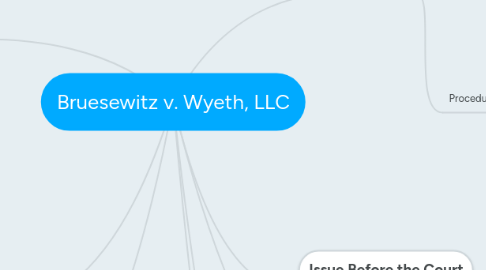
1. Impact of Decision
1.1. Am. Home Prods. Corp. v. Ferrari,
1.1.1. Cited in regards to the interpretation and preemption of 42 U.S.C. § 300aa-22(b)(1). Relevant context from case: "Only two federal district courts and one state other than Georgia have considered in published [***8] opinions whether 42 USC § 300aa-22 (b) (1) preempts all claims that a vaccine was defectively designed " Source: LexisNexis
1.2. Wright v. Aventis Pasteur, Inc.
1.2.1. Cited in regards to the clear intent and preemption of 42 U.S.C. § 300aa-22(b)(1). The court disfavored preemption and said that a vaccine's "unavoidable side effects" would be determined on a case by case basis. Relevant context from case: "would do nothing to protect vaccine manufacturers from suit from design defects, since such an inquiry would require a fact finder to consider the manufacturer's design against a purported safer alternative." Source: LexisNexis
2. Why should a business professional care?
2.1. As a business professional, it is critical to understand the necessary precautions I need to take to ensure my company is not sued for strict product liability as the legal costs can be detrimental to my business.
2.2. As a product manufacturer in the vaccine market, it is important to be aware that a federal law can protect me from strict liability, including design defects.
3. Business Practices
3.1. Vaccine manufacturers can continue to operate in the market and develop new products without fear of costly tort-liability.
3.2. As discussed in Wright v. Aventis Pasteur, Inc., businesses must adequately warn consumers of harmful products in their vaccines. Although the court did not rule in favor of the plaintiff in this case, businesses must be aware of substances banned by the FDA and adequately warn consumers of potential side effects.
4. Issue Before the Court
4.1. Whether 42 U.S.C. § 300aa-22(b)(1) of the NCVIA protects vaccine manufacturers from tort-liability suits filed by injured patients who claim design defects.
4.1.1. The court must make a decision regarding the immunization of vaccine manufacturers from tort liability.
4.1.1.1. If the court decides that manufacturers are not always protected from claims of design defects, vaccine manufacturers would become more vulnerable to tort liability.
5. Facts
5.1. Parties
5.1.1. Plaintiff: Russell and Robalee Bruesewitz, parents of Hannah Bruesewitz
5.1.2. Defendant: Wyeth, LLC, international pharmaceutical and healthcare company
5.2. What Happened
5.2.1. Hannah Bruesewitz experienced seizures 24 hours after receiving a dose of the DTP vaccine in 1992.
5.2.1.1. Hannah received the vaccine as part of the CDC's recommended childhood immunization schedule.
5.2.1.2. Hannah experienced over 100 seizures in the following month.
5.2.1.2.1. Her pediatrician diagnosed her with "residual seizure disorder" and "developmental delay."
5.2.1.3. The type of vaccine Hannah received was removed from the market by Wyeth in 1998.
5.3. Procedural History
5.3.1. Hannah's parents filed a claim under the National Childhood Vaccine Injury Act (NCVIA).
5.3.1.1. NCVIA is a no fault compensation program for people injured by vaccines.
5.3.1.1.1. Successful claimants receive compensation for medical, rehab, counseling, etc.
5.3.1.1.2. Manufacturers are typically protected from tort-liability if they've complied with regulatory requirements and provided adequate warnings.
5.3.1.2. The claim was denied.
5.3.1.2.1. Hannah's parents sued Wyeth, LLC, the vaccine's manufacturer, alleging strict product liability.
5.3.1.2.2. 1 month prior to the Bruesewitzs' claim, Hannah's diagnosis was removed from the list of compensable injuries.
6. Application
6.1. Hannah's parents claimed Wyeth, LLC's DTP vaccine caused Hannah's disabilities.
6.2. Hannah's parents alleged Wyeth, LLC was under strict product liability for defective design.
6.2.1. The plaintiff asserted that Wyeth should have developed a safer vaccine and should be liable for the injuries caused by the vaccine's defective design.
6.2.1.1. The type of vaccine Hannah received was removed from the market by Wyeth in 1998.
6.2.1.2. A federal judge ruled that the NCVIA protected Wyeth from lawsuits over vaccine injury claims and dismissed the case.
6.2.1.2.1. The NCVIA preempts all design-defect claims against vaccine makers presented by plaintiffs seeking compensation for injuries caused by a vaccine.
7. Conclusion
7.1. The U.S. Supreme Court affirmed the lower court's judgment.
7.1.1. The court ruled that the NCVIA preempts all design-defect claims against vaccine manufacturers presented by plaintiffs who seek compensation for injuries caused by a vaccine.
7.1.1.1. The majority of the justices determined the special vaccine court system was put in place in order to compensate injured patients without forcing drug manufacturers to leave the vaccine market.
8. Rule of Law
8.1. Strict Product Liability
8.1.1. Liability regardless of intentions or exercise of reasonable care
8.1.2. Plaintiff must prove:
8.1.2.1. (1) The product was unreasonably dangerous, (2) The product did not undergo any changes prior to reaching the consumer, and (3) The plaintiff's injury was due to the defective product.
8.1.2.2. For design defects, (1) a reasonable alternative must have been available and (2) the seller's decision not to use the alternative caused the product to be unreasonably dangerous.
